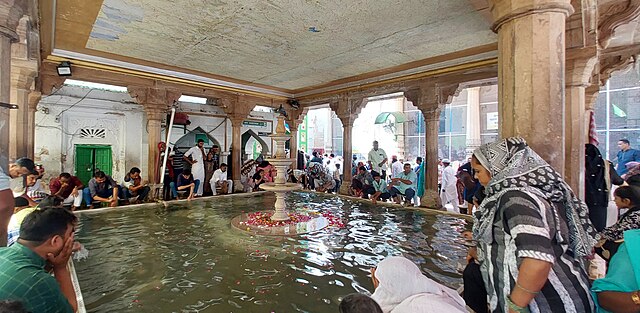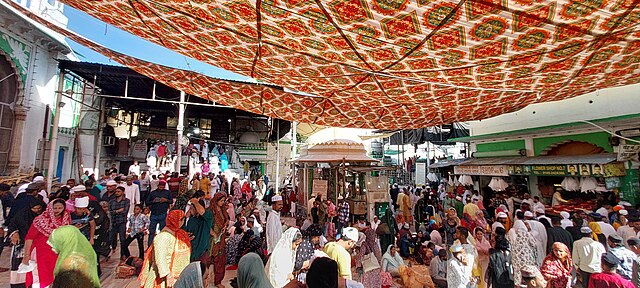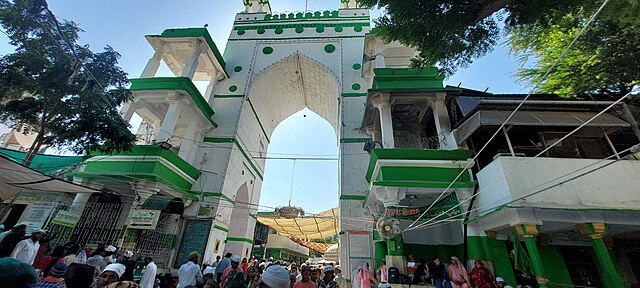Have you ever wondered what draws millions of pilgrims to a single location in Rajasthan every year? The answer lies in the mystical aura of Ajmer Sharif Dargah, one of India’s most revered Sufi shrines. This sacred destination isn’t just a religious site – it’s a melting pot of cultures, faiths, and spiritual experiences that transcends religious boundaries.
Whether you’re planning a spiritual pilgrimage or simply curious about India’s rich Islamic heritage, this comprehensive guide will help you navigate everything you need to know about visiting Ajmer Sharif Dargah. From understanding its historical significance to practical travel tips, we’ve got you covered.
What Makes Ajmer Sharif Dargah So Special?
Ajmer Sharif Dargah stands as a testament to India’s syncretic culture, where people of all faiths come together in search of peace and blessings. But what exactly makes this place so extraordinary?
The Sacred History Behind the Shrine
The dargah houses the tomb of Khwaja Moinuddin Chishti, a 13th-century Persian saint who dedicated his life to spreading love, compassion, and spiritual enlightenment. Known as “Gharib Nawaz” (Helper of the Poor), the saint’s teachings emphasized the importance of serving humanity regardless of caste, creed, or religion.
The shrine was built over several centuries, with various rulers contributing to its magnificence. The Mughal emperors, particularly Akbar, showed immense devotion to the saint and made regular pilgrimages to the dargah. This royal patronage helped establish Ajmer Sharif as one of the most important pilgrimage sites in the subcontinent.
Why Millions Visit This Holy Site
What draws people to Ajmer Sharif isn’t just religious fervor – it’s the universal message of love and equality that the saint preached. The dargah welcomes visitors from all backgrounds, creating an atmosphere where differences dissolve in the face of shared humanity.
The shrine is believed to fulfill the wishes of those who visit with pure hearts and sincere intentions. Stories of miraculous healings, answered prayers, and spiritual transformations have spread far and wide, attracting seekers from across the globe.
Understanding Khwaja Moinuddin Chishti

To truly appreciate your visit to Ajmer Sharif, it’s essential to understand the remarkable saint whose final resting place it is.
The Saint’s Life and Teachings
Born in Isfahan, Persia, around 1141 CE, Khwaja Moinuddin Chishti arrived in India during the late 12th century. His journey wasn’t just geographical – it was a spiritual mission to spread the message of divine love and universal brotherhood.
The saint’s philosophy was beautifully simple yet profoundly impactful. He believed that the highest form of devotion was serving humanity, especially the poor and downtrodden. His famous saying, “Love all and hate none, mere talk of peace will avail you naught,” continues to resonate with people centuries later.
His Impact on Indian Sufism
Khwaja Moinuddin Chishti is credited with establishing the Chishti order of Sufism in India. This mystical branch of Islam emphasizes love, tolerance, and the pursuit of divine truth through spiritual practices like music, poetry, and meditation.
His approach to spirituality was revolutionary for its time. Unlike orthodox practices that often excluded people based on social status or religious background, the saint’s teachings welcomed everyone. This inclusive philosophy laid the foundation for India’s unique Ganga-Jamuni tehzeeb (composite culture).
Planning Your Visit to Ajmer Sharif
Timing is everything when it comes to visiting Ajmer Sharif Dargah. Let’s explore the best times to visit and how to get there.
Best Time to Visit
The ideal time to visit Ajmer Sharif depends on what kind of experience you’re seeking.
Seasonal Considerations
October to March offers the most comfortable weather conditions. During these months, temperatures are pleasant, making it easier to explore the dargah complex and surrounding areas. The scorching Rajasthani summers (April to June) can be challenging for visitors, with temperatures soaring above 45°C.
The monsoon season (July to September) brings relief from the heat but can also mean unpredictable weather patterns. However, the post-monsoon period offers lush green surroundings and cooler temperatures.
Festival Times and Crowds
The annual Urs festival, commemorating the saint’s death anniversary, is the most significant event at Ajmer Sharif. Held in the seventh month of the Islamic calendar (Rajab), this six-day celebration attracts hundreds of thousands of pilgrims. While spiritually enriching, this period also means massive crowds and higher accommodation costs.
If you prefer a quieter, more contemplative experience, avoid the Urs festival and major Islamic holidays like Eid.
How to Reach Ajmer Sharif Dargah
Ajmer’s strategic location in Rajasthan makes it easily accessible from major Indian cities.
By Air
The nearest airport is Jaipur International Airport, approximately 135 kilometers from Ajmer. From there, you can hire a taxi or take a bus to reach the city. Several domestic airlines operate regular flights to Jaipur from Delhi, Mumbai, and other major cities.
By Train
Ajmer Junction is well-connected to India’s railway network, with direct trains from Delhi, Mumbai, Jaipur, Jodhpur, and other major cities. The railway station is just 2 kilometers from the dargah, making it the most convenient option for most travelers.
Popular trains include the Ajmer Shatabdi Express from Delhi and the Ajmer Express from Mumbai.
By Road
Ajmer is connected to major cities through an excellent network of national and state highways. The city is approximately 400 kilometers from Delhi, 135 kilometers from Jaipur, and 270 kilometers from Jodhpur.
State-run and private buses operate regular services to Ajmer from neighboring states. If you’re driving, the roads are generally in good condition, offering scenic views of Rajasthan’s landscape.
What to Expect During Your Visit
Understanding the layout and customs of Ajmer Sharif will enhance your spiritual experience.
The Dargah Complex Layout
The dargah complex is a architectural marvel that has evolved over centuries. As you enter through the main gate (Nizam Gate), you’ll be struck by the intricate Islamic architecture and the palpable sense of devotion.
The complex includes several important structures: the main tomb chamber where the saint rests, the Jama Masjid (congregational mosque), and various smaller shrines. The Akbari Masjid, built by Emperor Akbar, is another significant structure within the complex.
The tomb chamber itself is adorned with gold and silver decorations, with a marble lattice screen surrounding the actual grave. The atmosphere inside is charged with spiritual energy as devotees offer prayers and seek blessings.
Rituals and Customs
Participating in the traditional rituals can deepen your spiritual experience, but it’s important to understand and respect local customs.
Offering Prayers
Visitors typically offer prayers in Arabic, Persian, or their native language. There’s no prescribed format – sincere intentions matter more than linguistic perfection. Many devotees spend time in quiet contemplation, seeking spiritual guidance and inner peace.
Chadar and Flowers
Traditional offerings include chadar (ornate cloth coverings), flowers, and ittar (perfume). You can purchase these items from shops outside the dargah. The ritual of offering a chadar involves placing it over the saint’s tomb while making your prayers and wishes.
Accommodation Options in Ajmer

Ajmer offers accommodation options for every budget and preference.
Budget-Friendly Stays
For budget-conscious travelers, numerous guesthouses and dharamshalas offer clean, basic accommodation near the dargah. These options typically cost between ₹500-1500 per night and provide essential amenities.
The Rajasthan Tourism Development Corporation (RTDC) operates Hotel Khadim, which offers decent rooms at reasonable rates. Many of these budget accommodations are within walking distance of the dargah.
Luxury Hotels
If you prefer comfort and luxury, Ajmer has several upscale hotels. The Mansingh Palace and Hotel Sahil are popular choices offering modern amenities, excellent service, and comfortable rooms.
These luxury options typically range from ₹3000-8000 per night and often include facilities like swimming pools, spa services, and multi-cuisine restaurants.
Local Cuisine and Dining
No visit to Ajmer is complete without savoring the local Rajasthani and Mughlai cuisine.
Must-Try Dishes
Ajmer’s culinary landscape reflects its rich cultural heritage. Dal baati churma, the quintessential Rajasthani dish, is a must-try. The city is also famous for its Mughlai cuisine, including biryanis, kebabs, and rich gravies.
Don’t miss trying the local street food, especially the famous Ajmeri kalakand (a sweet) and sohan halwa. These traditional sweets make excellent souvenirs for friends and family.
Popular Restaurants
Honeydew Restaurant and Bhola Hotel are local favorites known for their authentic flavors and reasonable prices. For a more upscale dining experience, try the restaurants in luxury hotels, which often serve both Indian and international cuisine.
Shopping and Souvenirs
Ajmer’s markets offer a treasure trove of traditional Rajasthani handicrafts and religious artifacts.
What to Buy
Popular souvenirs include embroidered textiles, silver jewelry, wooden handicrafts, and religious items like prayer beads and Islamic calligraphy. The city is particularly famous for its brassware and traditional Rajasthani textiles.
Religious books, particularly those about Sufism and the saint’s teachings, make meaningful souvenirs for those interested in Islamic spirituality.
Best Markets
The Dargah Bazaar, located near the shrine, offers religious items, perfumes, and traditional crafts. For a more extensive shopping experience, visit the Naya Bazaar and Purani Mandi, which offer everything from textiles to jewelry at competitive prices.
Nearby Attractions
Extend your spiritual journey by exploring attractions near Ajmer.
Pushkar
Just 15 kilometers from Ajmer, Pushkar is one of Hinduism’s most sacred cities. Home to the only Brahma temple in the world, Pushkar offers a different but equally enriching spiritual experience. The annual Pushkar Camel Fair is a spectacular event that attracts visitors from around the globe.
Ana Sagar Lake
This artificial lake, created in the 12th century, offers a peaceful retreat from the bustling city. Evening boat rides provide beautiful sunset views, and the surrounding gardens are perfect for quiet contemplation.
Cultural Significance and Festivals
Understanding the cultural context enhances your appreciation of Ajmer Sharif’s significance.
Urs Festival
The annual Urs festival is the most important celebration at Ajmer Sharif. This six-day event features qawwali performances, poetry recitations, and spiritual discourses. The atmosphere during Urs is electric, with devotees from across the world gathering to pay their respects.
Other Important Celebrations
Throughout the year, various Islamic festivals and the saint’s other anniversaries are celebrated with great fervor. These occasions offer visitors insight into the rich traditions and spiritual practices associated with the dargah.
Photography and Etiquette Guidelines
Respecting local customs and religious sensitivities is crucial during your visit.
Photography inside the main tomb chamber is generally restricted, but you can capture the beautiful architecture of the outer areas. Always ask permission before photographing people, especially during prayer times.
Dress modestly – both men and women should cover their arms and legs. Women are required to cover their heads when entering the dargah premises. Remove your shoes before entering the tomb chamber, and maintain a respectful demeanor throughout your visit.
Safety Tips for Visitors
While Ajmer is generally safe for tourists, following basic precautions ensures a smooth visit.
Keep your valuables secure and be cautious of pickpockets in crowded areas. During festival times, the crowds can be overwhelming, so stay close to your group and plan your exit strategy in advance.
Stay hydrated, especially during summer visits, and carry basic medications. If you’re visiting during Ramadan, be respectful of those fasting and plan your meals accordingly.
Conclusion
Ajmer Sharif Dargah offers more than just a religious experience – it’s a journey into India’s rich spiritual heritage and a testament to the universal human quest for meaning and divine connection. Whether you come seeking blessings, spiritual enlightenment, or simply to understand India’s cultural diversity, the dargah welcomes all with open arms.
The saint’s message of love, compassion, and service to humanity remains as relevant today as it was eight centuries ago. As you walk through the hallowed halls of this sacred shrine, you’ll understand why millions of people from all walks of life continue to find solace and inspiration in this remarkable place.
Plan your visit thoughtfully, approach with an open heart, and prepare for a transformative experience that will stay with you long after you leave the sacred precincts of Ajmer Sharif Dargah.
Frequently Asked Questions (FAQs)
Q1: Is Ajmer Sharif Dargah open to people of all faiths?
A: Yes, absolutely. The dargah welcomes visitors from all religious backgrounds. The saint’s philosophy emphasized universal love and brotherhood, making it a place where people of all faiths can find spiritual solace.
Q2: What is the best time of day to visit the dargah?
A: Early morning and evening are ideal times to visit. The atmosphere is more peaceful, and the lighting creates a mystical ambiance. Avoid visiting during afternoon hours in summer due to extreme heat.
Q3: Are there any specific dress code requirements?
A: Yes, modest dress is required. Both men and women should wear clothes that cover arms and legs completely. Women must cover their heads with a scarf or dupatta when entering the dargah premises.
Q4: How much time should I allocate for visiting Ajmer Sharif?
A: Plan to spend at least 2-3 hours at the dargah to fully experience its spiritual atmosphere. If you want to explore nearby attractions like Pushkar, consider staying for 2-3 days in Ajmer.
Q5: Can I participate in the qawwali performances?
A: Yes, qawwali performances are open to all visitors. These soulful musical sessions typically take place in the evenings and during special occasions. Listening to qawwali is considered a form of spiritual practice in Sufi tradition.

